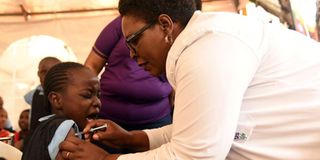Can Kenya end cervical cancer in next decade?

A healthcare worker administers the cervical cancer vaccine to Mwajuma Jillo at Hola Referral Hospital.
What you need to know:
- In 10 years, countries are expected to have stopped new cases through vaccination, screening and treatment of lesions.
- The management of cervical cancer faces many problems.
Last Wednesday, the World Health Assembly adopted a strategy to speed up the elimination of cervical cancer as a public health problem.
In 10 years, countries are expected to have stopped new cases through vaccination, screening and treatment of lesions that have not yet turned cancerous. But Kenyan women are increasingly getting cervical cancer and thousands die every year.
To blame is the low awareness levels and low investment in screening and treatment. A woman in an informal urban settlement, who has been bleeding for months, will ignore the flow for lack of knowledge that she has symptoms of cervical cancer.
She will fundraise Sh2,150 to finally do a scan in a public hospital after months in long queues. And when finally diagnosed with cervical cancer will be ridiculed as having ‘a disease of prostitutes’ – a term many loosely use, fuelling stigma.
Out of service
After finally travelling the hundreds of kilometres to the old cryotherapy machine, used to remove abnormal cells, it will have no gas. When she returns, the disease will have progressed but the radiotherapy or brachytherapy machine will be out of service and approval for spare parts delayed by corruption.
The ill-equipped public hospitals have exposed Kenya’s incapacity to promptly respond to cervical cancer, yet the World Health Organisation (WHO) hopes by 2030 it will have vaccinated 90 per cent of young girls against human papillomavirus (HPV), which causes cervical cancer; made precise tests affordable and easily accessible to 70 per cent of women 36-45; and treated 90 per cent of those with lesions that are not yet cancerous.
Also, 90 per cent of patients with advanced cancer should get palliative care, whether painkillers or end-of-life therapies.
The management of cervical cancer faces many problems. Resources are concentrated in cities, leaving rural areas and other low-income communities to their own devices. Messages are wrongly packaged, fuelling stigma and fear; women and girls do not identify as persons with cervixes. It’s a shame.
Community health workers do sensitisation on HIV/Aids and drug adherence but not cervical cancer — yet such women are at a higher risk of cancer.
Low-cost technologies
The ministry should adopt, on a large scale low-cost technologies such as thermoablation; a cheap, battery-powered portable device can be used to instantly treat precancerous lesions if there are no specialists and sophisticated machines nearby.
In areas with no laboratories, few local staff can be trained in low-cost screening methods such as applying vinegar to visually check for precancerous lesions and treat them with thermoablation.
Cervical cancer should no longer be seen as a “woman’s disease”. Let’s take the mystery out of the screening and treatment so that women can speak up and become advocates for their health. Now.




